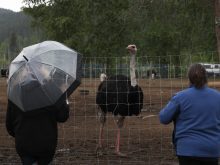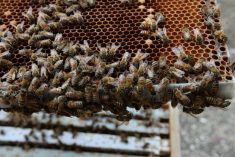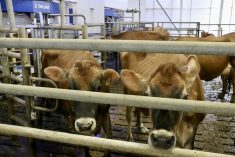A third poultry flock in southwestern Ontario has been confirmed with highly pathogenic H5N1 avian influenza — with another backyard flock now being tested, and the disease also now present in four U.S. border states.
The Canadian Food Inspection Agency (CFIA) on Wednesday announced it had confirmed the presence of high-path H5N1 in a poultry flock in the township of Woolwich, just north of Kitchener.
Further details about the type of birds or number of mortalities weren’t yet available Wednesday afternoon. The agency’s report on the new case isn’t yet publicly available from the World Organization for Animal Health (OIE).
Read Also

Ample supplies and improved livestock sector to boost Canadian feed sector: FCC
Abundant feed grain supplies and improved profitability for the livestock sector should support strong feed demand and sales through the winter, says a new report from Farm Credit Canada.
Cases were confirmed earlier this week in two commercial turkey flocks: one in the township of Guelph/Eramosa in Wellington County, also north of Kitchener, and the other in the township of Zorra in Oxford County, east of London.
As with the previous cases in Ontario, and in February at two farms in Nova Scotia, CFIA said Wednesday it “has placed the premises under quarantine and is establishing movement control measures and recommending enhanced biosecurity for other farms within that area.”
Separately, the Ontario poultry and egg industries’ Feather Board Command Centre, which monitors disease outbreaks in birds at the provincial, national and global levels, now says it’s monitoring reports of a “small backyard poultry flock with increased mortality” in southwestern Ontario’s upper Bruce Peninsula. There are no commercial flocks in that area, the FBCC said on its website, adding that lab tests are still pending in that case.
Other high-path H5N1 cases in Canada since last fall have included wild birds in all four Atlantic provinces and a bald eagle in the Vancouver area, plus domestic birds at two “non-poultry” farms in Newfoundland’s Avalon Peninsula and two non-commercial backyard flocks in Nova Scotia.
Since none of those cases involved commercial poultry, Canada had been considered free of high-path avian flu since 2015 just up until last month, when H5N1 was confirmed at a commercial poultry farm and at a mixed farm with poultry, both in western Nova Scotia.
After the on-farm cases in Nova Scotia were confirmed, several countries including the U.S., European Union, Japan and Korea imposed new import restrictions on Canadian poultry, eggs and/or other products, or on those from the affected province.
In the U.S. since February, cases of H5N1 have now been confirmed in commercial poultry and/or backyard flocks in 23 states — including four states directly bordering Canada.
As of Wednesday, the U.S. Department of Agriculture’s Animal and Plant Health Inspection Service said it’s confirmed cases in flocks in Connecticut, Delaware, Illinois, Indiana, Iowa, Kansas, Kentucky, Maine, Maryland, Massachusetts, Michigan, Minnesota, Missouri, Nebraska, New Hampshire, New York, North Carolina, North Dakota, Ohio, South Dakota, Virgina, Wisconsin and Wyoming.
The North Dakota outbreak, APHIS said Wednesday, is in a “non-commercial backyard chicken flock” at Kidder County, a south-central jurisdiction east of Bismarck. Minnesota’s cases have included a commercial turkey flock in Meeker County, west of Minneapolis; a “backyard mixed species” flock in Mower County, south of Rochester; and a commercial turkey flock in Stearns County, northwest of Minneapolis.
Among other states bordering Canada, cases of H5N1 were confirmed last month in two non-commercial backyard flocks in Knox County on Maine’s southern coast and in Suffolk County on New York’s Long Island.
This month cases were also confirmed in backyard flocks in Maine’s coastal Lincoln, York and Washington counties — the latter of which borders New Brunswick — and in a backyard flock and birds on a commercial game farm, both also in New York’s Suffolk County.
Avian flu viruses can, on rare occasions, cause disease in people, usually in cases where they’ve had close contact with infected birds or “heavily contaminated” environments, CFIA says.
Clinical signs in infected birds can include “high and sudden” mortality rates as well as declines in production of eggs, many of which are soft-shelled or shell-less; diarrhea; hemorrhages on the hock; quietness and “extreme depression;” swelling of the skin under the eyes; and swollen and congested wattles and combs.
Good biosecurity measures include maintaining “high sanitation standards” in barns and “strict control” over access to poultry houses; keeping poultry away from areas frequented by wild birds; cleaning and disinfecting equipment before taking it into poultry houses; and siting bird feeders or duck ponds well away from poultry barns.
CFIA also recommends people working with poultry suspected of being infected with avian flu, or in contact with such birds, wear protective clothing including face masks, goggles, gloves and boots. — Glacier FarmMedia Network

















